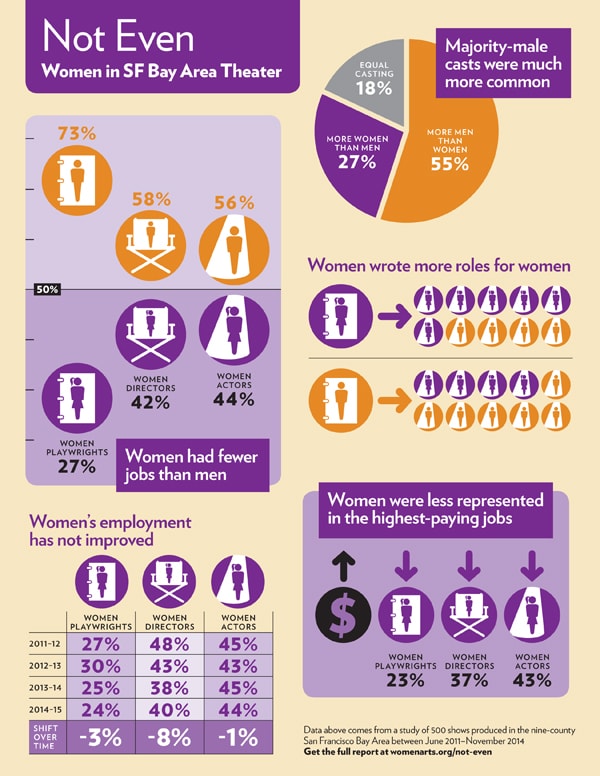SAN FRANCISCO: The nonprofit WomenArts, an advocacy group for female artists, has released a study looking the gender breakdowns of casts and crews in 500 professional Bay Area productions. It finds that between 2011 and 2014, women made up just 27 percent of the playwrights produced, while they comprised 42 percent of directors hired and 44 percent of the actors onstage.
“Something is off for women theatre artists in the San Francisco/Bay Area,” writes study author Valerie Weak in the study introduction. Weak is a Bay Area actor/educator. “It has been particularly shocking to discover just how few opportunities there are for female playwrights here.”
The study, called “Not Even,” authored by Weak—in collaboration with Martha Richards, executive director of WomenArts, and Christine Young, associate professor at the University of San Francisco—can be read in full here.
Other highlights from the study include:
- Women are less represented in higher-paying jobs. For example, female union actors made up 53 percent of nonunion/showcase jobs but only 39 percent on Equity contracts with health weeks. Male playwrights also outnumbered female playwrights three to one on the highest union contracts.
- When it comes to modern plays (written from 1960 onward), women made up 31 percent of modern plays produced in the Bay Area; they made up a minuscule 3 percent of classic plays produced.
- Women are more likely to write plays with female characters; female directors are more likely to work with female playwrights.
An infographic from the study is below:

The WomenArts study joins previous regional studies in gender disparity in theatre. Previous findings from the League of Professional Theatre Women, released last year, showed that in 355 Off-Broadway productions, women made up 30 percent of playwrights and 30 percent of directors. Numbers from playwright Gwydion Suilebhan in Washington, D.C., the Los Angeles Female Playwright Initiative and the Chicago Gender Equity Report are also available online. In addition, in our October issue, American Theatre reported that in the 2014–15 season, only 24 percent of the plays produced nationwide are written by women.
The study also details what steps theatres, playwrights, actors and audiences can take to close the gender gap. Writes Weak: “Over the course of working on the project, I’ve come to realize that while I have no control over what projects a company chooses to produce, or whether or not I am cast in a project, I do have control over the material I use to audition. I now actively seek out the work of female playwrights to use for audition monologues. When I’m auditioning, I feel that I’m not just there to vie for a role, but also to introduce a director or an artistic leader to a female playwright they could be producing.”

